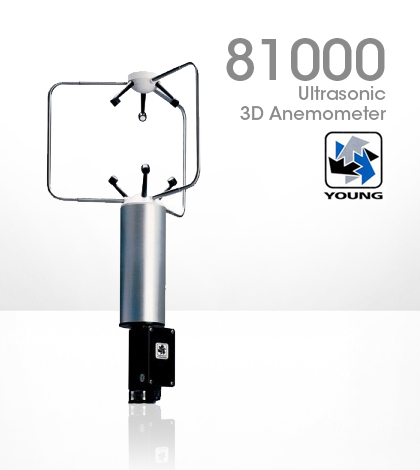RM Young 81000 Ultrasonic Anemometer: Fast response, high resolution for 3D wind data

The RM Young 81000 Ultrasonic Anemometer is a high-quality 3-axis wind sensor with no moving parts. It is perfectly suited for applications requiring fast response, high resolution and three dimensional wind measurements.
With no moving parts, the sensor is less susceptible to damage from field deployment and is a good choice over the long term. The “81000 uses ultrasonic sound waves to measure wind velocity,” said Andy Oliver, product manager at the RM Young Company.
The sensor measures wind speed based on the time of flight of sonic pulses between pairs of transducers. The 81000 also measures the speed of sound, an intriguing parameter of its own.
“The speed of sound varies depending on the temperature of the air through which the sound moves,” said Oliver. “If we know the speed of sound, we can calculate the air temperature.”
That calculation might be necessary in one of the sensor’s many field applications, which include measuring turbulent air in the atmosphere; wind resource assessment; and as part of weather monitoring stations.
Across the sensor’s uses, its data is very precise. Oliver says its best features are its ability to measure wind at very low speeds and quick changes in the wind. An important feature to note, however, is the anemometer’s ability to easily interface with industry standard data loggers.
The 81000 offers voltage and serial outputs, including RS-232 and RS-485. The 81000V model has four voltage input channels instead of voltage outputs for applications requiring synchronized analog measurements.
Given its stable construction, measurement precision and interface capabilities, the Young 81000 is an economical solution for environmental professionals, says Oliver, especially for three-dimensional wind monitoring where fast response is required.
The sensor’s maintenance is also light. Oliver says the transducers should be kept free of snow, ice, dirt or anything that could disturb the signal. An annual inspection and cleaning is recommended in conjunction with a calibration check.




Daniel Fernandez (Professor)
June 3, 2020 at 8:16 pm
Hello – I am interested in purchasing a 3D anemometer for eddy flux measurements involving fog. I am not sure which configuration is optimal for my needs and which additional data logging or interface instrumentation I would need.
Katelyn Kubasky
June 17, 2020 at 3:08 pm
Daniel, please send us an email at customercare@fondriest.com we would be happy to discuss.